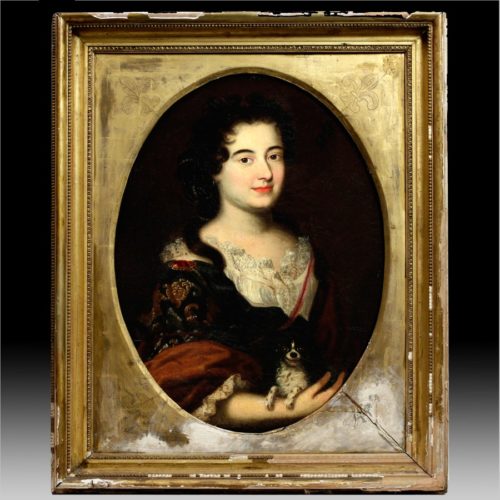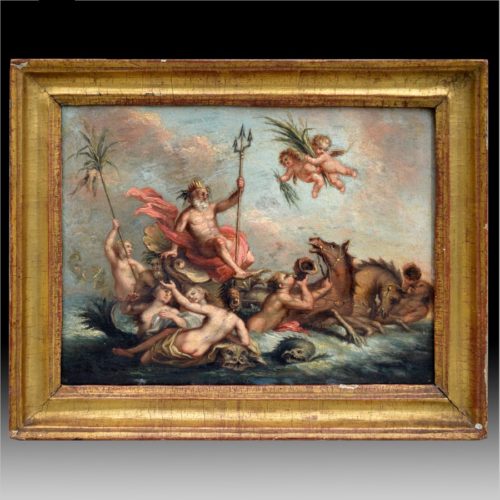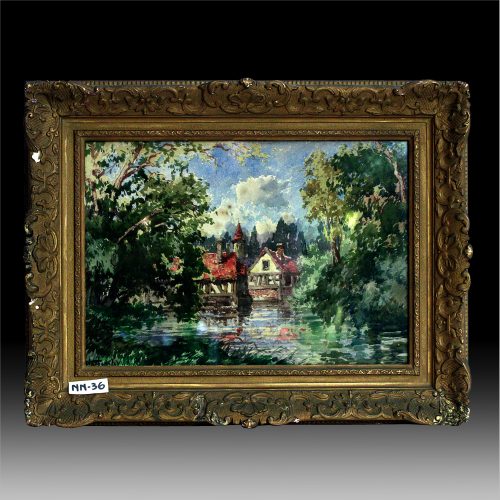-
Henri Gascars ‘Portrait of a Lady, half length in a blue Dress with a white Chemise and a brown Wrap, holding a Spaniel' Bears inscription on a label on the reverse ‘Mrs. Cunliffe' oil on canvas, in a painted oval 27 x 19 ½ in. 68.6 x 49.5 cm. Henri Gascar (1635 – 1 Jan 1701) (also Gascard, Gascars) was a French-born portrait painter who achieved artistic success in England during the reign of Charles II. He painted many leading ladies at court, including several of the King's mistresses, before returning to Paris. He subsequently relocated to Rome, where he died in 1701. Gascar came to England about 1674, probably at the behest of Louise de Keroualle, Duchess of Portsmouth, Charles II's favourite mistress. Gascar (or Gascard, as he seems to have spelt his name at first) was already known as a skillful portrait-painter; among the portraits already painted by him was that of Nicolas de Lafond, author of the "Gazette of Holland", painted in 1667, and engraved by Peter Lombart. The patronage of the Duchess of Portsmouth ensured Gascar a rapid success in England. His flamboyant style, contrasting with the stolid English approach, seemed to suit the frivolity of the time and he painted many of the ladies of Charles II's court. His lack of attention to detail in the likeness he made up for by the sumptuous draperies and tawdry adornments around the subject. For a short time he became fashionable, and is said to have amassed a fortune of over £10,000.
-
François Boucher 1703-1770, French “The Triumph of Neptune” François Boucher (French; 29 September 1703 – 30 May 1770) was a French painter, draughtsman and etcher, who worked in the Rococo style. Boucher is known for his idyllic and voluptuous paintings on classical themes, decorative allegories, and pastoral scenes. He was perhaps the most celebrated painter and decorative artist of the 18th century. He also painted several portraits of his patroness, Madame de Pompadour. A native of Paris, Boucher was the son of a lesser known painter Nicolas Boucher, who gave him his first artistic training. At the age of seventeen, a painting by Boucher was admired by the painter François Lemoyne. Lemoyne later appointed Boucher as his apprentice, but after only three months, he went to work for the engraver Jean-François Cars. Boucher died on 30 May 1770 in his native Paris. His name, along with that of his patron Madame de Pompadour, had become synonymous with the French Rococo style, leading the Goncourt brothers to write: "Boucher is one of those men who represent the taste of a century, who express, personify and embody it." OM-300 CL102794-139640801-2
-
Georges William Thornley (British, b. 1857-1935) ‘The Watermill’ signed, watercolor on paper 11 x 15 ½ in. (27.9 x 39.4 cm) Georges William Thornley (1857–1935) was a French painter and printmaker. A student of the French landscape painter Eugène Ciceri and Edmond Yon, Thornley became a successful artist remembered for his seascapes from Normandy and his landscapes from the French and Italian Rivieras. He was the son of a Welsh immigrant Morgan Thornley. He also was a talented watercolorist, engraver, and lithographer. His lithographs after the works of Corot, Pissarro, Degas and Puvis de Chavannes were acclaimed by his peers and awarded at the Salon de Paris. His paintings were exhibited beginning in 1878. He won the Mention of Honor in 1881 and a Third Class medal in 1888. Thornley embraced the Impressionist movement early in his career, which brought him much success. His style characteristically has bold brushwork and thick "impasto." It recreates the "impression of a panorama", capturing the fleeting moment in its inner light and color. This open landscape is an example of what the artist excelled at: successful color effects which are highly decorative but stay true to nature.



